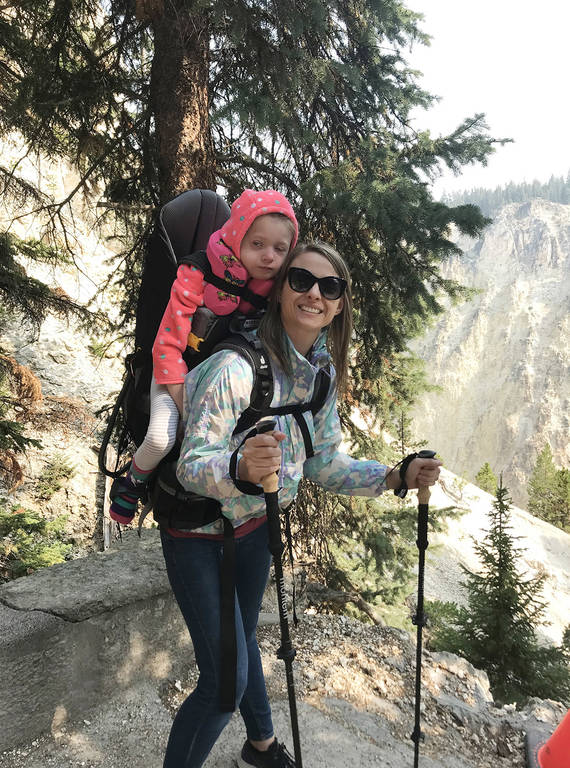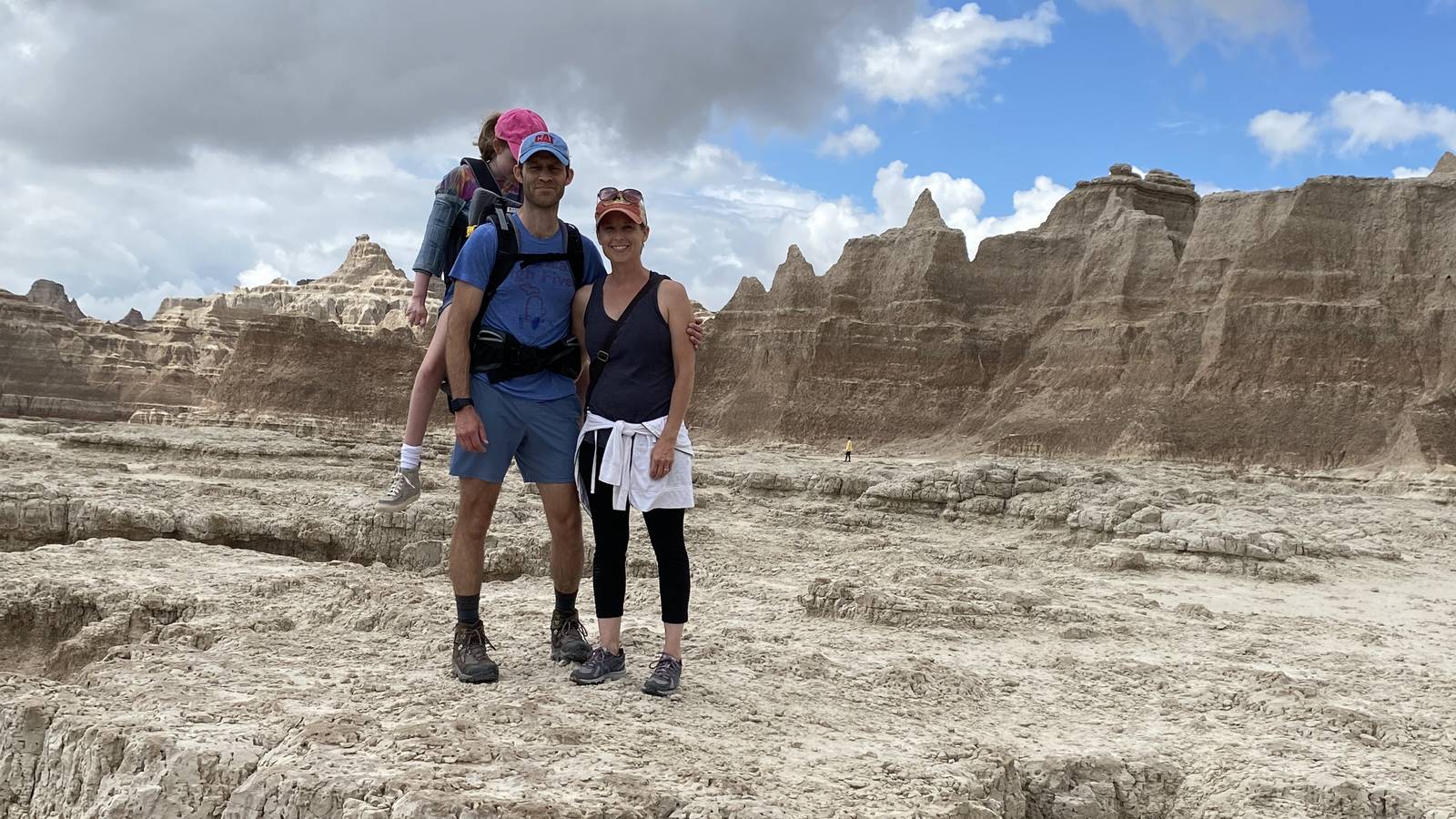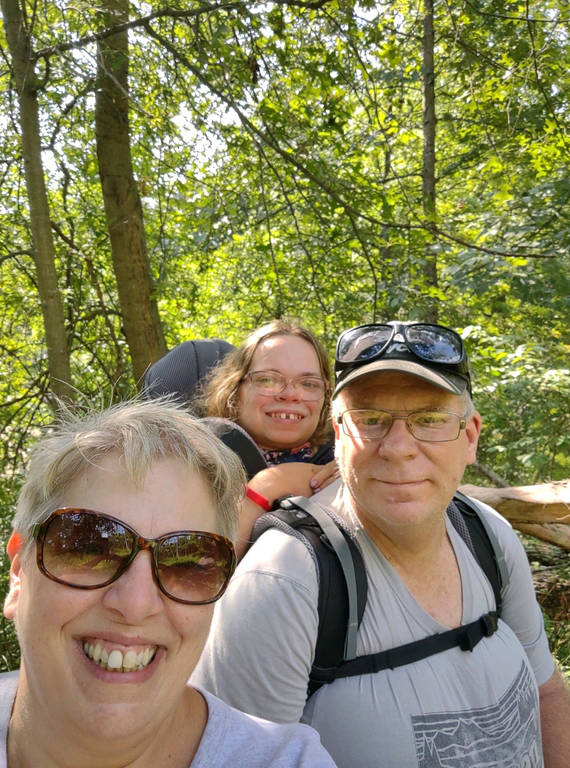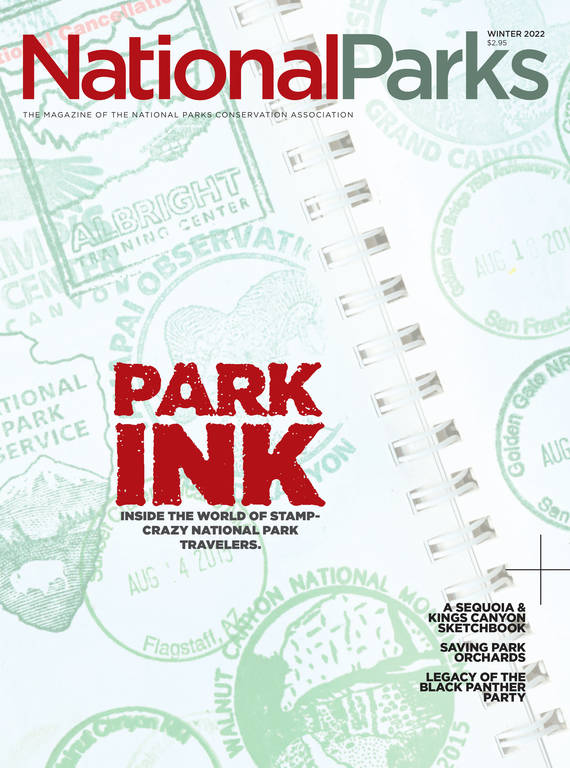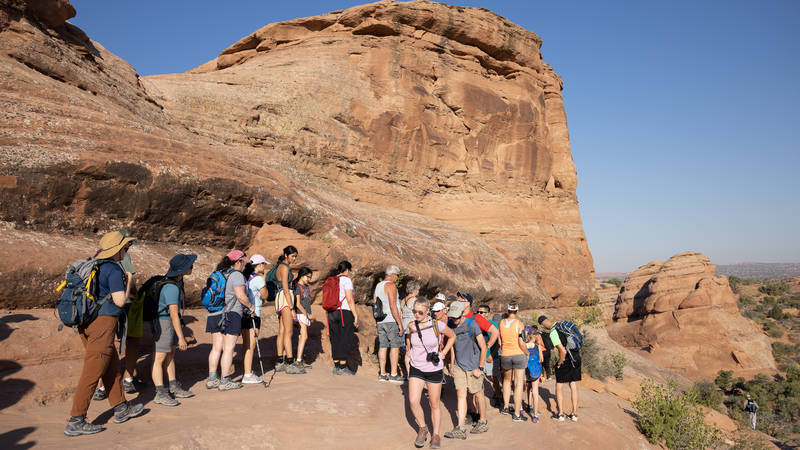Winter 2022
Creative Access
Some visitors with disabilities are venturing farther into parks with the help of specialized backpacks, family and friends.
Going up the ladder with her father was a precarious proposition. Sarah Van Orden had dreamed of seeing the Ancient Puebloan cliff dwellings in Mesa Verde National Park in Colorado since she was a kid, but perched high above the ground on wooden rungs, she felt her anxiety swell. Still, she trusted her dad. She had to: She was hitching a ride on his back.
“My dad is 57 and still carrying me,” she said in a recent phone call. “He has no fear.”
Van Orden has a syndrome known as Morquio A, a rare condition that causes bone irregularities, dwarfism, and breathing and heart problems. At 24, she is 3 feet, 3 inches tall and weighs around 60 pounds. She can walk short distances — at Mount Rushmore, she managed to hike a 1.25-mile trail — but it’s exhausting, and she relies on a wheelchair much of the time. She loves to travel, though, and her enthusiasm often draws her toward out-of-the-way areas. That’s where her customized backpack comes in.
Van Orden and her parents, Tom and Ruth, had used different carrier packs over the years, mostly ones marketed for children, which she eventually outgrew. But this summer, she was strapped into a pack specifically designed for people with physical disabilities, a product they’d recently purchased from the nonprofit organization We Carry Kevan. Using that pack or similar carriers, families with disabled members are finding ways to go deeper into parks and other outdoor spaces than wheelchair-accessible routes typically allow.
“The technology that allows access to recreation is constantly evolving,” Jeremy Buzzell, the branch chief for the National Park Service’s accessibility management program, said in an email. While data about disabled parkgoers is hard to come by, Buzzell noted that spikes in visitation, which some national parks experienced last year, inevitably correspond with an increase in the number of visitors with disabilities. And that’s who tends to lead the way when it comes to accessibility advancement. “People with disabilities are the real experts on making parks more accessible,” he said.

Hiking with Spoons
An advocate in the Pacific Northwest turned a frustrating hike into a mission to make parks more welcoming for the millions of people with disabilities and chronic illnesses.
See more ›So far, the Van Ordens have notched 43 states and 19 national parks, from Canyonlands to Acadia — part of a quest to visit all 50 states and as many parks as possible. On their frequent road trips from their home in Lancaster, Pennsylvania, backpack carriers have been Sarah Van Orden’s ticket to rugged trails and waterfalls alongside her family. “I can get to the bottom of the canyon and the top of the mountain. That would not be physically possible for me otherwise,” she said.
We Carry Kevan was founded by Kevan Chandler, a writer and accessibility advocate who knows the ins and outs of adventuring while disabled, including the use of a carrier. In 2016, when he was 29, he and three friends traveled across Europe, and because of Chandler’s limited mobility due to spinal muscular atrophy, his friends took turns carrying him in a Deuter Kid Comfort 3 backpack they had retrofitted with additional straps and supports. They had a blast on the trip, making connections with strangers and solving logistical puzzles. The pack, Chandler said, was “the tangible representation of working together and thinking outside the box.”
Back in the U.S., Chandler penned a memoir about the Europe trip and started the nonprofit, which has a staff of four, including his sister, who shares his spinal muscular atrophy diagnosis. The organization aims to encourage interdependence and foster creative thinking around accessibility. It also produces the carrier in partnership with Deuter, a German sports pack company that Chandler first reached out to after his trip abroad. Initial funding for the factory model came from the nonprofit’s board and pre-sales; the pack, which can support someone who weighs up to 70 pounds, became available for purchase in 2019.
At $375, the pack is comparable in price to other higher-end carriers; the nonprofit offers free packs to families who can’t afford them. So far, We Carry Kevan has sold close to 400 packs and distributed nearly 250 free packs around the world.
Some other companies that primarily make carriers designed with kids in mind also market their wares to disabled hikers. One of the three brothers who founded Piggyback Rider has a child who is disabled, and that’s part of why they knew early on that their carriers could assist users with mobility issues, said Ray Gibson, who works in customer service. The company offers discounts to buyers with disabilities. Nathan Jones, co-founder of The Freeloader, said that his company’s pack — which can support up to 80 pounds — has been useful for disabled people (and their families), who make up about half of his customer base. “It’s our main driver of international sales,” he said.
Ellanor and Sabrina Blanchett hike to the Lower Falls of the Grand Canyon of the Yellowstone River in Yellowstone National Park.
©EMILY MORROWJohn and Colleen Foster hike around Badlands National Park with their daughter Emmy.
COURTESY OF JOHN FOSTERSarah Van Orden with her parents at Gettysburg National Military Park in Pennsylvania last summer.
COURTESY OF RUTH VAN ORDEN
Several pieces of legislation — including the Architectural Barriers Act of 1968 and the Americans with Disabilities Act of 1990 — require the Park Service to accommodate visitors with special needs, particularly in and around visitor centers and facilities such as bathrooms, water fountains and lodging. Through the Access Pass program, U.S. residents with permanent disabilities can apply for a free lifetime park pass, and wheelchair rentals are available in some parks — including over-sand models with inflatable tires at Great Sand Dunes National Park and Preserve in Colorado.
Still, many families say wheelchair icons on maps don’t necessarily tell the whole story, and finding the sort of nuanced information they need about terrain and elevation changes on trails can sometimes be frustrating. That’s true even at a park such as Yellowstone, which is known for being well adapted for folks with mobility issues. Sabrina Blanchett found that out this summer, when she brought her daughter, Ellanor, who uses a wheelchair full time, to the park. “We’d use the chair to start but have to leave somebody with Ellanor and finish alone,” she said. “There were rock pathways to get to the wooden boardwalks. Pushing a wheelchair on gravel is really difficult.”
LEARN MORE
In recent years, the Park Service has upped its accessibility efforts. A year ago, the agency released a final report from its Accessibility Task Force, after a five-year initiative that expanded accessibility training for staff, required each park to add an “accessibility” tab to its website, and planned projects in nine parks, resulting in additions like a new ramp at the National Mall in Washington, D.C. — slated for completion in 2023 — and a freshly paved 2,600-foot trail at Mammoth Cave in Kentucky.
But not all families want to stick to the smooth, curated routes. “Families and people with disabilities appreciate the flat surfaces and elevators, but we also want adventure just like anyone else,” Kevan Chandler said. “One of my favorite things about going hiking with my friends is the struggle and challenge of it.”
Blanchett hit the road this August, heading to Yellowstone and Grand Teton national parks from her small town of Ponder, Texas. In addition to Ellanor, 8, she was traveling with her husband, Chris, and their daughters, Joslin, 11, and Margaux, 5. Ellanor has Aicardi syndrome, which affects brain development, and in her case has caused blindness and epilepsy. In the past, Blanchett said, “we never thought hiking was an option. How do you do that with a kid who doesn’t sit on her own, or walk or talk?” But for this trip, they obtained a carrier and researched some backcountry trails. Blanchett toted Ellanor on a 4-mile excursion and down switchbacks into a canyon. “We were finally able to do a family outdoor hike,” she said.

National Parks
You can read this and other stories about history, nature, culture, art, conservation, travel, science and more in National Parks magazine. Your tax-deductible membership donation of $25 or more entitles…
See more ›After seeing a post about a carrier on Facebook, John and Colleen Foster got one for their daughter, Emmy, who is 13 and has Rett syndrome, an extremely rare neurological disorder that primarily affects girls and limits walking, hand use and speech, among other abilities. This summer, the Fosters loaded Emmy and her sisters, Ava, 15, and Olivia, 9, into their minivan and drove from their home in the Chicago area to South Dakota, where they visited Mount Rushmore, Badlands National Park and other sites nearby. On a few hikes, John carried Emmy in the pack, while the others trekked beside them. “She had the feeling of getting out there and hiking right along with her sisters,” he said. “She was cracking up, slapping me on my head, loving it.” He noticed they got more smiles and encouraging comments from strangers than they did when steering Emmy in a wheelchair back home. “There’s definitely a camaraderie about having someone on your back,” he said.
That is a big part of what propels Chandler: a deeply held belief in the power of shared outdoor experiences and of people helping people. “Really that’s the vision for the world as a whole, isn’t it? That our hearts would open up to people and that we would be open-handed and willing to invite each other into our own situations and into the world around us,” he said. “So we’re trying to encourage that in the best way possible.”
About the author
-
 Dorian Fox Contributor
Dorian Fox ContributorDorian Fox is a writer and freelance editor whose essays and articles have appeared in various literary journals and other publications. He lives in Boston and teaches creative writing courses through GrubStreet and Pioneer Valley Writers' Workshop. Find more about his work at dorianfox.com.
